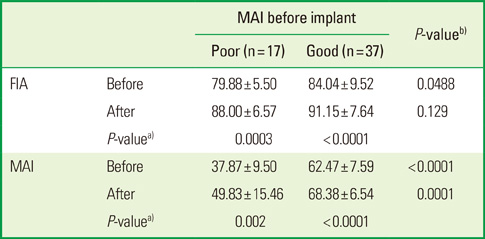1. Kim BI, Jeong SH, Chung KH, Cho YK, Kwon HK, Choi CH. Subjective food intake ability in relation to maximal bite force among Korean adults. J Oral Rehabil. 2009; 36:168–243.

2. Sato H, Fueki K, Sueda S, Sato S, Shiozaki T, Kato M, et al. A new and simple method for evaluating masticatory function using newly developed artificial test food. J Oral Rehabil. 2003; 30:68–73.

3. Ahn HJ, Lee YS, Jeong SH, Kang SM, Byun YS, Kim BI. Objective and subjective assessment of masticatory function for patients with temporomandibular disorder in Korea. J Oral Rehabil. 2011; 38:475–556.

4. Park HU, Kim BI, Kang SM, Kim ST, Choi JH, Ahn HJ. Changes in masticatory function after injection of botulinum toxin type A to masticatory muscles. J Oral Rehabil. 2013; 40:916–938.

5. Choi TH, Kim BI, Chung CJ, Kim HJ, Baik HS, Park YC, et al. Assessment of masticatory function in patients with non-sagittal occlusal discrepancies. J Oral Rehabil. 2015; 42:2–9.

6. Papaspyridakos P, Chen CJ, Singh M, Weber HP, Gallucci GO. Success criteria in implant dentistry: a systematic review. J Dent Res. 2012; 91:242–250.
7. Gibbard LL, Zarb G. A 5-year prospective study of implant-supported single-tooth replacements. J Can Dent Assoc. 2002; 68:110–116.
8. Norton MR. Biologic and mechanical stability of single-tooth implants: 4- to 7-year follow-up. Clin Implant Dent Relat Res. 2001; 3:214–234.
9. Norton MR. Multiple single-tooth implant restorations in the posterior jaws: maintenance of marginal bone levels with reference to the implant-abutment microgap. Int J Oral Maxillofac Implants. 2006; 21:777–861.
10. Esposito M, Grusovin MG, Willings M, Coulthard P, Worthington HV. The effectiveness of immediate, early, and conventional loading of dental implants: a Cochrane systematic review of randomized controlled clinical trials. Int J Oral Maxillofac Implants. 2007; 22:893–904.
11. Jeong SH, Kang SM, Ryu JH, Kwon HK, Kim BI. Subjective food intake ability in relation to the Mixing Ability Index in Korean adults. J Oral Rehabil. 2010; 37:242–249.

12. van der Bilt A. Assessment of mastication with implications for oral rehabilitation: a review. J Oral Rehabil. 2011; 38:754–834.

13. Gonçalves TM, Campos CH, Gonçalves GM, de Moraes M, Rodrigues Garcia RC. Mastication improvement after partial implant-supported prosthesis use. J Dent Res. 2013; 92:Suppl. 189S–194S.

14. Hamdan NM, Gray-Donald K, Awad MA, Johnson-Down L, Wollin S, Feine JS. Do implant overdentures improve dietary intake? A randomized clinical trial. J Dent Res. 2013; 92:Suppl. 146S–153S.

15. de Bruyn H, Collaert B, Lindén U, Björn AL. Patient’s opinion and treatment outcome of fixed rehabilitation on Brånemark implants. A 3-year follow-up study in private dental practices. Clin Oral Implants Res. 1997; 8:265–336.
16. Roos J, Sennerby L, Lekholm U, Jemt T, Gröndahl K, Albrektsson T. A qualitative and quantitative method for evaluating implant success: a 5-year retrospective analysis of the Brånemark implant. Int J Oral Maxillofac Implants. 1997; 12:504–518.
17. Moraschini V, Poubel LA, Ferreira VF, Barboza ED. Evaluation of survival and success rates of dental implants reported in longitudinal studies with a follow-up period of at least 10 years: a systematic review. Int J Oral Maxillofac Surg. 2015; 44:377–465.

18. Awad MA, Lund JP, Shapiro SH, Locker D, Klemetti E, Chehade A, et al. Oral health status and treatment satisfaction with mandibular implant overdentures and conventional dentures: a randomized clinical trial in a senior population. Int J Prosthodont. 2003; 16:390–396.
19. Reisine S, Freilich M, Ortiz D, Pendrys D, Shafer D, Taxel P. Quality of life improves among post-menopausal women who received bone augmentation during dental implant therapy. Int J Oral Maxillofac Surg. 2012; 41:1558–1620.

20. Lucas PW, Luke DA. Is food particle size a criterion for the initiation of swallowing? J Oral Rehabil. 1986; 13:127–163.

21. Kim MS, Lee JK, Chang BS, Um HS. Masticatory function following implants replacing a second molar. J Periodontal Implant Sci. 2011; 41:79–85.

22. Hildebrandt GH, Dominguez BL, Schork MA, Loesche WJ. Functional units, chewing, swallowing, and food avoidance among the elderly. J Prosthet Dent. 1997; 77:588–683.

23. Sarita PT, Witter DJ, Kreulen CM, Van’t Hof MA, Creugers NH. Chewing ability of subjects with shortened dental arches. Community Dent Oral Epidemiol. 2003; 31:328–362.








 PDF
PDF ePub
ePub Citation
Citation Print
Print




 XML Download
XML Download